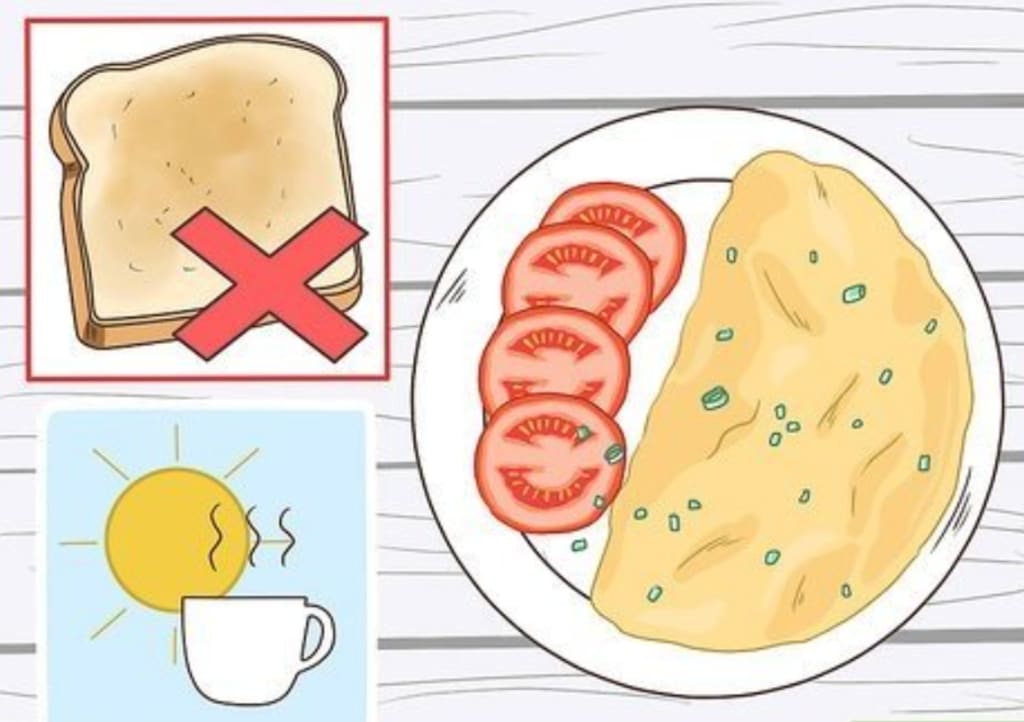Do you really have to eliminate bread from your diet
What should a diet be like where you don't give up eating bread

## Do You Really Have to Eliminate Bread from Your Diet?
Bread. It's a staple in many diets around the world, from the fragrant baguettes of Paris to the dense rye loaves of Eastern Europe and the soft, pillowy naan of South Asia. Yet, in the era of low-carb, gluten-free, and keto diets, bread has become a contentious topic. Some say it's the root of all dietary evils, while others can't imagine life without it. So, do you really have to eliminate bread from your diet?
### The Nutritional Value of Bread
Bread, particularly whole grain varieties, is a good source of essential nutrients:
- **Carbohydrates**: The body's primary energy source.
- **Fiber**: Essential for digestive health, whole grain bread is often a great source.
- **B Vitamins**: Including folate and thiamine, important for energy production and brain health.
- **Minerals**: Such as iron and magnesium.
However, not all bread is created equal. The nutritional value can vary significantly based on ingredients and processing.
### The Carbs Conundrum
One of the main reasons people ditch bread is to cut down on carbohydrates. Diets like keto and Atkins promote extreme carbohydrate reduction, aiming to push the body into a state of ketosis, where fat is burned for energy instead of carbs.
While low-carb diets can be effective for weight loss, they may not be sustainable or necessary for everyone. Carbohydrates, including those from bread, are essential for many bodily functions, especially for those who are physically active or have high energy needs.
### Gluten: The Villain or a Misunderstood Component?
Gluten, a protein found in wheat, barley, and rye, is another reason bread is often avoided. For individuals with celiac disease, gluten causes serious health issues. For others with non-celiac gluten sensitivity, consuming gluten can lead to discomfort and digestive problems.
However, many people without these conditions eliminate gluten—and thus bread—unnecessarily. Gluten itself isn't harmful unless you have a sensitivity or intolerance. In fact, many gluten-free breads lack the nutritional profile of their gluten-containing counterparts, often compensating with higher fat or sugar content to achieve a similar texture and taste.
### Bread and Blood Sugar
Another concern is the effect of bread on blood sugar levels. Refined white bread can cause rapid spikes in blood glucose, which over time can contribute to insulin resistance and type 2 diabetes.
Choosing whole grain or multigrain bread with lower glycemic indices can mitigate these spikes. Whole grains take longer to digest, leading to a slower release of glucose into the bloodstream.
### Moderation Over Elimination
The key to a healthy diet is balance and moderation. Bread can be a part of a healthy diet if chosen wisely and consumed in reasonable amounts.
- **Opt for Whole Grains**: Choose whole grain or whole wheat bread over refined white bread.
- **Watch the Portions**: Pay attention to serving sizes to avoid excessive calorie intake.
- **Pair Smartly**: Combine bread with protein and healthy fats to slow down digestion and avoid blood sugar spikes.
- **Read Labels**: Look for bread with minimal ingredients and avoid those with added sugars and preservatives.
### Listen to Your Body
Ultimately, the decision to keep or eliminate bread from your diet should be based on how your body responds to it. If you have a medical condition like celiac disease or diabetes, you might need to avoid certain types of bread or be more mindful of your choices.
For most people, though, bread doesn't need to be the enemy. Enjoy it as part of a varied and balanced diet. Savor that slice of sourdough or whole grain toast. Life is too short to miss out on the simple pleasure of a good piece of bread.
### Conclusion
Bread has been a dietary cornerstone for thousands of years, and for good reason. It provides essential nutrients and, when chosen wisely, can be part of a healthy, balanced diet. So, before you toss that loaf aside, consider your dietary needs, listen to your body, and make informed choices. You don't necessarily have to eliminate bread from your diet to be healthy; it might just be about finding the right type and balance for you.
## Embracing Bread: Crafting a Balanced Diet Without Giving Up the Loaf
Bread, with its comforting aroma and satisfying texture, is a beloved food around the world. Yet, in today’s diet culture, bread often finds itself on the “do not eat” list. But what if you could maintain a balanced diet and enjoy bread? Good news: you can! Here’s how to integrate bread into a healthy eating plan without compromising your nutritional goals.
### The Case for Keeping Bread
Bread isn’t just a source of carbohydrates; it can also provide vital nutrients, fiber, and even a sense of culinary joy. Here’s why bread deserves a place at your table:
- **Energy Boost**: Bread, especially whole grain varieties, is a great source of complex carbohydrates, which provide a steady release of energy.
- **Fiber Content**: Whole grain bread is rich in dietary fiber, which supports digestive health and can help keep you feeling full longer.
- **Nutrient-Rich**: Many breads are fortified with essential vitamins and minerals, including B vitamins (thiamine, riboflavin, niacin, folate) and iron.
### Choosing the Right Bread
Not all breads are created equal. Here’s what to look for to make a healthier choice:
1. **Go Whole Grain**: Choose breads made from whole grains. These include whole wheat, oats, barley, and rye. Whole grains retain the bran and germ, offering more fiber, vitamins, and minerals than refined grains.
2. **Check the Ingredients**: Look for bread with a short ingredient list, indicating minimal processing. Avoid those with high levels of added sugars, unhealthy fats, or artificial additives.
3. **Mind the Fiber**: Aim for bread with at least 3 grams of fiber per serving. Fiber is crucial for digestive health and helps control blood sugar levels.
4. **Low Glycemic Index**: Select breads with a low glycemic index (GI). These breads have a slower impact on blood sugar levels, making them better choices for sustained energy and metabolic health.
### Integrating Bread into a Balanced Diet
Incorporating bread into a healthy diet doesn’t mean indulging in large, unmonitored quantities. It’s about balance and pairing bread with nutrient-dense foods. Here’s how:
1. **Portion Control**: Enjoy bread in moderation. A single serving of bread is typically one slice. Adjust your portions based on your dietary needs and activity level.
2. **Pair with Protein and Healthy Fats**: Combine bread with sources of protein and healthy fats to create balanced meals that keep you fuller longer. Think avocado toast with a poached egg or a sandwich with lean turkey and fresh vegetables.
3. **Incorporate Vegetables**: Add veggies to your bread-based meals. Pile on the leafy greens, tomatoes, cucumbers, and peppers to boost the nutritional profile and add fiber.
4. **Diversify Your Meals**: Don’t make bread the star of every meal. Enjoy a variety of whole grains, vegetables, fruits, lean proteins, and healthy fats throughout the day.
5. **Be Mindful of Spreads and Toppings**: Choose healthy toppings like nut butter, hummus, or cottage cheese instead of butter or sugary spreads. These options provide extra nutrients without excess calories or unhealthy fats.
### Sample Meals with Bread
Here are some delicious, balanced meal ideas that include bread:
- **Breakfast**: Whole grain toast topped with avocado, cherry tomatoes, and a sprinkle of chili flakes, served with a side of Greek yogurt and berries.
- **Lunch**: A turkey and vegetable sandwich on whole grain bread, accompanied by a mixed greens salad with olive oil and balsamic vinegar.
- **Dinner**: Grilled chicken breast served with a slice of whole grain bread, roasted vegetables, and a quinoa salad.
- **Snack**: A slice of whole grain bread with almond butter and banana slices or a small piece of dark chocolate.
### Addressing Common Concerns
**Will Eating Bread Make Me Gain Weight?**
Weight gain is typically a result of overall calorie intake exceeding what you burn. Bread alone isn’t a direct cause of weight gain. Enjoying bread in appropriate portions as part of a balanced diet should not lead to weight gain.
**Can Bread Fit into a Low-Carb Diet?**
If you’re following a low-carb diet, you don’t have to eliminate bread entirely. Opt for bread made with almond flour or other low-carb ingredients, or enjoy smaller portions of regular bread.
**What If I Have a Gluten Sensitivity?**
For those with gluten intolerance or celiac disease, gluten-free bread options are available. Choose those made from whole grains like brown rice, quinoa, or millet to get similar nutritional benefits.
### The Joy of Bread
Bread is more than just a food; it’s a symbol of culture, tradition, and simple pleasures. By making informed choices and enjoying it as part of a varied diet, you can savor bread without sacrificing your health goals. So, whether it’s a hearty whole grain loaf or a slice of sourdough, keep the bread and enjoy it as part of a balanced, nourishing diet. Keto Breads Reviews
### Final Thoughts
Embracing bread doesn’t mean compromising on health. By choosing wisely, managing portions, and pairing it with nutritious foods, bread can be a delightful part of your meals. Remember, a healthy diet is about balance and variety, not deprivation. Enjoy your bread and the diverse flavors it brings to your plate.
About the Creator
peter
Content about cars, motorbikes, technology, news
Enjoyed the story? Support the Creator.
Subscribe for free to receive all their stories in your feed. You could also pledge your support or give them a one-off tip, letting them know you appreciate their work.






Comments
There are no comments for this story
Be the first to respond and start the conversation.